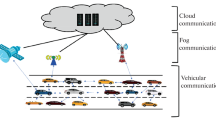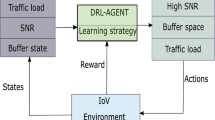Abstract
Clustering is an efficient technique for achieving high scalability on the Internet of Vehicles (IoV). However, the latency and overhead generated from forming and maintaining clusters are common barriers to the mass adoption of this technique. To this end, we propose an efficient clustering scheme for the IoV. Leveraging reinforcement learning, our scheme can quickly form network condition-aware clusters. In addition, our reinforcement learning-based clustering scheme (RLBC) assures dynamic and cooperative maintenance for clusters. The effectiveness of our scheme is evaluated through extensive simulations. The simulation results show that the RLBC outperforms a previously developed approach and allows for more persistent cluster heads with higher durations and stable connections with their members.















Similar content being viewed by others
References
Li G, Boukhatem L, Wu J (2016) Adaptive quality-of-service-based routing for vehicular ad hoc networks with ant colony optimization. IEEE Trans Veh Technol 66(4):3249–3264
Hafeez KA, Anpalagan A, Zhao L (2015) Optimizing the control channel interval of the dsrc for vehicular safety applications. IEEE Trans Veh Technol 65(5):3377–3388
IEEE Std (2010) 802.11p TM-2010-IEEE standard for information technology–local and metropolitan area networks–specific requirements–part 11: wireless LAN medium access control (MAC) and physical layer (PHY) specifications amendment 6: Wireless Access in Vehicular Environments
IEEE Standard for Wireless Access in Vehicular Environments (WAVE) (2016) Multi-channel operation. IEEE Std 1609.4–2016 (Revision of IEEE Std 1609.4–2010): 1–94
Yang F, Tang Y (2014) Cooperative clustering-based medium access control for broadcasting in vehicular ad-hoc networks. IET Commun 8(17):3136–3144
Sepulcre M, Gozalvez J, Altintas O, Kremo H (2016) Integration of congestion and awareness control in vehicular networks. Ad Hoc Netw 37:29–43
Pal R, Gupta N, Prakash A, Tripathi R (2018) Adaptive mobility and range based clustering dependent MAC protocol for vehicular ad hoc networks. Wireless Pers Commun 98(1):1155–1170
Hafeez KA, Zhao L, Mark JW, Shen X, Niu Z (2013) Distributed ultichannel and mobility-aware cluster-based MAC protocol for vehicular ad hoc networks. IEEE ransactions on vehicular Technology 62(8):3886–3902
Hassanabadi B, Shea C, Zhang L, Valaee S (2014) Clustering in vehicular ad hoc networks using affinity propagation. Ad Hoc Netw 13:535–548
Santos RA, Edwards RM, Seed NL (2002) Using the cluster-based location routing (CBLR) algorithm for exchanging information on a motorway. In 4th international workshop on mobile and wireless communications network (pp. 212–216). IEEE
Cooper C, Franklin D, Ros M, Safaei F, Abolhasan M (2016) A comparative survey of VANET clustering techniques. IEEE Communications Surveys & Tutorials 19(1):657–681
Ibrahim K, Weigle MC (2008) CASCADE: cluster-based accurate syntactic compression of aggregated data in VANETs. In 2008 IEEE Globecom Workshops (pp. 1–10). IEEE
Huo Y, Liu Y, Ma L, Cheng X, Jing T (2016) An enhanced low overhead and stable clustering scheme for crossroads in VANETs. EURASIP J Wirel Commun Netw 2016(1):1–13
Ren M, Khoukhi L, Labiod H, Zhang J, Veque V (2016) A new mobility-based clustering algorithm for vehicular ad hoc networks (VANETs). In NOMS 2016–2016 IEEE/IFIP Network Operations and Management Symposium (pp. 1203–1208). IEEE
Su H, Zhang X (2007) Clustering-based multichannel MAC protocols for QoS provisionings over vehicular ad hoc networks. IEEE Trans Veh Technol 56(6):3309–3323
Lin CR, Gerla M (1997) Adaptive clustering for mobile wireless networks. IEEE J Sel Areas Commun 15(7):1265–1275
Basu P, Khan N, Little TD (2001) A mobility based metric for clustering in mobile ad hoc networks. In Proceedings 21st International Conference on Distributed Computing Systems Workshops (pp. 413–418). IEEE
Morales MMC, Hong CS, Bang YC (2011) An adaptable mobility-aware clustering algorithm in vehicular networks. In 2011 13th asia-pacific network operations and management symposium (pp. 1–6). IEEE
Maglaras LA, Katsaros D (2013) Clustering in urban environments: virtual forces applied to vehicles. In 2013 IEEE International Conference on Communications Workshops (ICC) (pp. 484–488). IEEE
Ahizoune A, Hafid A (2012) A new stability based clustering algorithm (SBCA) for VANETs. In 37th Annual IEEE Conference on Local Computer Networks-Workshops (pp. 843–847). IEEE
Shea C, Hassanabadi B, Valaee S (2009) Mobility-based clustering in VANETs using affinity propagation. In GLOBECOM 2009–2009 IEEE Global Telecommunications Conference (pp. 1–6). IEEE
Bi X, Guo B, Shi L, Lu Y, Feng L, Lyu Z (2020) A new affinity propagation clustering algorithm for V2V-supported VANETs. IEEE Access 8:71405–71421
Sutton RS, Barto AG (1998) Reinforcement learning: an introduction. IEEE Trans Neural Networks 9(5):1054–1054
Bouk SH, Kim G, Ahmed SH, Kim D (2015) Hybrid adaptive beaconing in vehicular ad hoc networks: a survey. Int J Distrib Sens Netw 11(5):390360
Varga A (2001) Using the OMNET++ discrete event simulation system. In European Simulation multi conference (ESM’01) Prague, Czech Republic
Sommer C, German R, Dressler F (2011) Bidirectionally coupled network and road traffic simulation for improved IVC analysis. IEEE Trans Mob Comput 10(1):3–15
Krajzewicz D, Erdmann J, Behrisch M, Bieker L (2012) Recent development and applications of SUMO-simulation of urban mobility. International journal on advances in systems and measurements 5(3&4)
Author information
Authors and Affiliations
Corresponding author
Additional information
Publisher's note
Springer Nature remains neutral with regard to jurisdictional claims in published maps and institutional affiliations.
Rights and permissions
About this article
Cite this article
Zerrouki, H., Moussaoui, S., Derder, A. et al. Reinforcement learning-based clustering scheme for the Internet of Vehicles. Ann. Telecommun. 76, 685–698 (2021). https://doi.org/10.1007/s12243-021-00879-3
Received:
Accepted:
Published:
Issue Date:
DOI: https://doi.org/10.1007/s12243-021-00879-3




